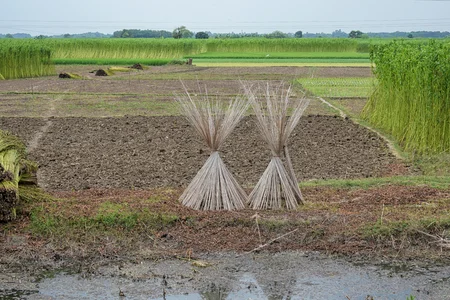Jute is cultivated commercially as a cash crop. Its plant is a dicot, fibrous, in which a thin and cylindrical stem emerges. It is also known as Jute. The Jute plant is 6 to 10 feet tall, and the fiber is prepared by rotting the plant. Many things are made from this fiber. It also makes sackcloth, sacks, rugs, ropes, tents, paper and quality clothes, from which people get cash. Jute plants have a humid and hot climate, and their cultivation needs moist air. Therefore, good quality fibre is found when moisture is in the air.
Suitable Land
Jute is cultivated in light sandy loam soil and should not be enabled in waterlogged land. Because if the water remains for a long time, the plants start dying. Because of this, its plants need average rain. But abnormal rainfall is detrimental to the yield. Jute is grown in the summer and rainy season, due to which the effect of winter is not seen on the crop. Jute plant germinates at 20 to 25 degrees temperature; after germination, it can tolerate temperatures up to 35 degrees. For more suitable soil fertility farmers used the Kubota b2741 tractor model because it is affordable.
Field Preparation
Before cultivating Jute, its land must be adequately prepared. The better the field is ready, the better the yield will be. While preparing the land, do deep ploughing with ploughs and leave the field open like this. Due to this, the sunlight gets deep into the ground. After this, apply cow dung and cultivator and do two to three slant ploughing. This way, the compost will mix well in the soil and then apply water. After a few days of watering, when weeds start coming out, get ploughing done using a rotavator. This will make the soil moist and crispy. The ability of seed germination increases in moist soil, and the seed grows well.
Transplanting Method
Sowing jute seeds is done in the form of sources by spraying and drilling methods like wheat and millet. In the spraying method, the seeds are mixed in the soil by sprinkling them in the ploughing flat field after light ploughing. Apart from this, seeds are planted in rows for transplanting through a drill. Seeds are used in the spraying method.
Planting jute seeds can be done from February to June and mid-July, depending on the variety and environment. Good yield can be obtained by sowing the seeds at the right time.
Amount of Fertiliser
The field must give proper fertiliser to get more yield from the jute crop. For this, at the time of the first ploughing of the area, 25 to 30 tonnes of rotted cow dung is mixed well in the soil. Farmers can use organic fertilisers as well as chemical fertilisers. Apart from this, give half the amount of nitrogen with plant irrigation twice.
Jute Cultivation in Rain
Jute plants require very little water. Because its seeds are planted at the time when it is the rainy season all over India. The months of March to June are the season of rain and monsoon.
Weed Control
Its crop also has to be protected from weeds. To control weeds in jute crop, weeding has to be done. The first wedding of its plants should be done after 25 to 30 days of sowing when the plant becomes about one foot. After this, do the hoeing for 15 to 20 days. Also, for weed control tractors are used efficiently and the kubota mu4501 tractor model is the best option if you want to buy.
Fiber Removal
The bundles must be kept in water for 20 to 25 days to extract the fibre from the jute plants. After this, they are taken out, and the thread is removed from the rotten plants, which are cleaned by washing them with clean water. To dry these pure fibres, keep them in the open sun on a wood block for three to four days. During this, the threads marked in the sun should be kept turning so that the fibre’s moisture content is less because excess moisture spoils the fibers. Because the stretched thread becomes weak for a long time, the quality decreases because the prices are also not good in the market.
Stay connected with us for more detailed blogs.





![Best Social Media Marketing Name Ideas to Attract [2024] Social Media Marketing Names in 2024](https://gonobuddy.com/wp-content/uploads/2024/03/Top-100-Creative-Social-Media-Marketing-Names-in-2024-218x150.jpeg)







